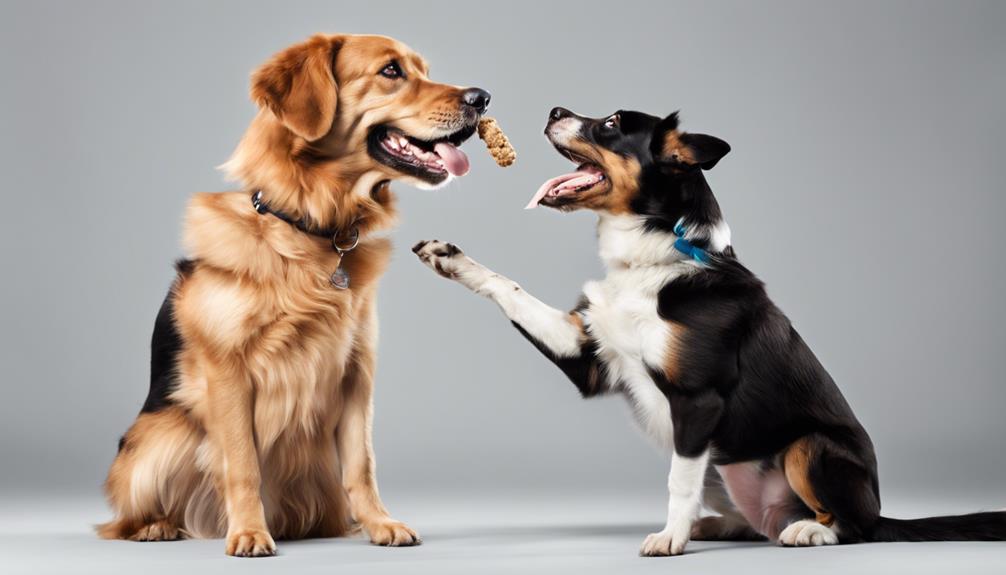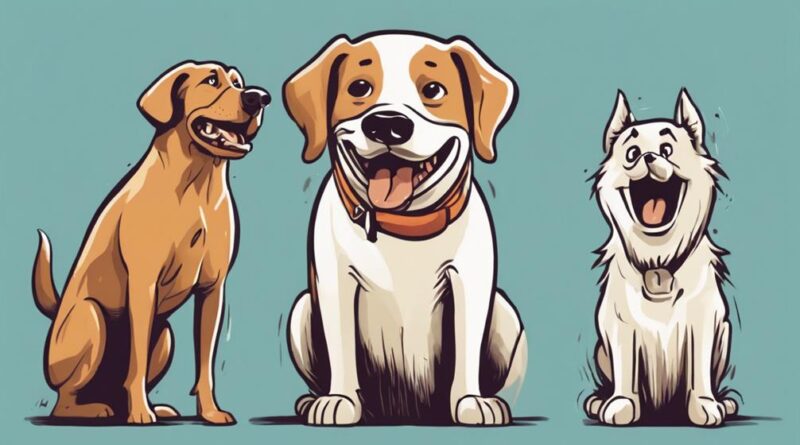Why Do Dogs React Differently to Humans?
Have you ever wondered why dogs seem to have a mysterious code when it comes to interacting with humans?
It's not just your imagination at play. Dogs' unique reactions stem from a complex interplay of factors that go beyond simple obedience or instinct.
From their keen sense of smell to their ability to pick up on subtle cues in your body language, there are numerous fascinating reasons behind why dogs respond the way they do.
Understanding these dynamics can lead to more harmonious and fulfilling relationships with our canine companions.
Canine Social Hierarchy and Behavior
Understanding how dogs establish their social hierarchy and how it influences their behavior is crucial for interpreting their reactions to humans. Dominance dynamics play a significant role in shaping how dogs interact with both other dogs and humans. In a pack setting, dogs use dominance cues to determine their rank within the group. These cues can include body posture, vocalizations, and physical actions. By recognizing these dominance dynamics, you can better understand why a dog may exhibit certain behaviors, such as resource guarding or territorial aggression.
Moreover, social cues also play a vital role in how dogs perceive and respond to human interactions. Dogs are highly attuned to human body language, tone of voice, and gestures. They can quickly pick up on subtle cues that indicate leadership or submission. For example, a direct gaze may be seen as a challenge by a dog, while avoiding eye contact can signal submissiveness. By being aware of these social cues, you can establish a positive relationship with your furry companion based on mutual respect and understanding.
Impact of Human Body Language
Have you ever considered how your body language influences your dog's reactions towards you? Dogs are highly attuned to nonverbal cues, including your facial expressions. Here's how your body language can impact your furry friend:
- Posture: Your posture communicates a lot to your dog. Standing tall and open can convey confidence and authority, while slouching may signal submissiveness.
- Eye Contact: Dogs interpret direct eye contact in different ways. Sustained eye contact can be seen as a challenge or a sign of affection, depending on the context.
- Gestures: Simple gestures like pointing or waving can either confuse or excite your dog. Consistent use of gestures can help reinforce commands and strengthen the bond between you.
- Facial Expressions: Just like humans, dogs can read facial expressions. Smiling can reassure your dog, while a furrowed brow might indicate tension or displeasure. Be mindful of the messages your facial expressions are sending to your canine companion.
Influence of Tone of Voice
Your tone of voice plays a crucial role in how your dog perceives your commands and emotions. Dogs are highly attuned to vocal cues, picking up on subtle variations in pitch, volume, and intonation. When giving commands, using a firm and clear tone can convey authority and seriousness, prompting your dog to respond promptly. Conversely, a gentle and soothing tone can communicate comfort and reassurance, especially during stressful situations.
Emotional responses are also heavily influenced by the tone of voice you use. Dogs can sense your mood through the way you speak, whether you're happy, angry, or sad. A cheerful tone can evoke excitement and playfulness in your dog, while a harsh tone may lead to fear or anxiety. It's essential to maintain a consistent and appropriate tone when interacting with your dog to ensure clear communication and positive outcomes. By being mindful of your tone of voice, you can strengthen the bond with your furry companion and enhance mutual understanding.
Role of Olfactory Communication
Paying attention to your dog's sense of smell is crucial in understanding their communication patterns and behaviors. Dogs rely heavily on olfactory signals to communicate with each other and with humans.
Here are some key points to consider regarding canine scent communication:
- Powerful Communication Tool: Dogs use scent marking to establish territories and convey information about themselves to other dogs.
- Emotional Signaling: Canine scent communication is also used to express emotions such as fear, stress, or relaxation.
- Social Bonding: Dogs exchange scent cues during interactions to strengthen social bonds within their packs.
- Recognizing Individuals: Through olfactory signals, dogs can identify and differentiate between different individuals, including humans, based on their unique scents.
Understanding the role of olfactory communication in dogs can help you interpret their behaviors and strengthen your bond with your furry companion.
Understanding Canine Pack Mentality
To truly understand your dog's behavior, it's essential to grasp the concept of canine pack mentality. Dogs are social animals with pack dynamics ingrained in their behavior. In the wild, they live in packs led by an alpha, establishing a dominance hierarchy crucial for their survival and cooperation.
Within a pack, there are clear roles and positions that dictate behavior and interactions. Understanding these dynamics can help you comprehend why your dog may display certain behaviors at home. Dogs often seek to establish their position within the family unit, looking for leadership and guidance from their human pack members.
Recognizing the pack mentality in your dog can aid in training and strengthening your bond. By acknowledging their natural instincts for hierarchy, you can establish yourself as the pack leader, providing structure and guidance. This can help address behavioral issues and create a harmonious relationship based on respect and trust. Understanding pack dynamics and dominance hierarchy is key to fostering a healthy and balanced connection with your canine companion.
Effects of Human-Canine Bonding
Understanding canine pack mentality provides a foundation for exploring the effects of human-canine bonding on a dog's behavior and well-being. When you forge a strong bond with your dog, remarkable things happen:
- Canine Empathy: Dogs possess an incredible ability to empathize with their human companions. They can sense your emotions and respond accordingly, offering comfort and support in times of need.
- Loyalty: Through bonding, dogs develop unwavering loyalty towards their owners. This loyalty is a testament to the deep connection and trust they feel towards you.
- Human-Animal Connection: The bond between humans and dogs goes beyond simple companionship. It's a profound connection that enriches both parties' lives and fosters mutual understanding.
- Trust: Building a bond with your dog is built on trust. As you strengthen this trust through positive interactions and consistent care, you create a secure and loving relationship that benefits both you and your furry friend.
Significance of Positive Reinforcement

Utilizing positive reinforcement techniques is crucial in fostering a strong and healthy relationship with your canine companion. Treat rewards play a key role in encouraging desirable behaviors in your dog. When your furry friend exhibits positive behavior, such as following a command or displaying good manners, rewarding them with treats reinforces that behavior and increases the likelihood of it being repeated. This creates a positive association between good behavior and the reward, strengthening your bond with your dog.
Clicker training is another effective method that uses a clicking sound to mark the precise moment when your dog performs the desired behavior, followed by a treat reward. This technique helps your dog understand exactly what they did right, making the training process clearer and more efficient. By consistently using clicker training alongside treat rewards, you can communicate effectively with your dog and build a harmonious relationship based on positive reinforcement techniques. Remember, positive reinforcement not only teaches your dog good behavior but also enhances your connection with them.
Training Techniques for Better Interaction
When improving your interactions with your canine companion, incorporating effective training techniques is essential for fostering a harmonious relationship. Utilizing reward-based training methods can significantly enhance your communication cues with your dog. By rewarding desired behaviors promptly, you reinforce positive actions and encourage your furry friend to repeat them in the future. This approach helps your dog understand what you expect from them, creating a stronger bond and mutual understanding.
Here are some key training techniques that can aid in better interaction with your dog:
- Reward Based Training: Using treats or toys to reward good behavior.
- Communication Cues: Teaching your dog specific signals for commands.
- Positive Reinforcement: Encouraging desired behaviors through praise and rewards.
- Body Language Cues: Paying attention to your dog's body language to understand their feelings and reactions.
Frequently Asked Questions
Are There Specific Breeds of Dogs That Are More Likely to React Differently to Humans?
Certain dog breeds exhibit unique tendencies in their reactions to humans. These behaviors can vary widely based on breed characteristics. Factors such as socialization and training methods also play a significant role in shaping a dog's response to humans.
Can a Dog's Past Experiences With Humans Affect How They React to Them in the Future?
Your dog's past experiences with humans can greatly influence how they interact with people in the future. Trust issues may arise if they've had negative encounters, impacting their behavior.
Behavioral training can help address these issues. Attachment styles and socialization techniques play a key role in shaping a dog's response to humans.
Do Dogs React Differently to Different Genders of Humans?
When it comes to how dogs react to different genders of humans, it's all about body language cues and the socialization process. Dogs may respond differently based on past experiences and behavioral training. They can pick up on subtle signals, so your interactions matter.
Olfactory sensitivity plays a role too. Keep in mind that every dog is unique, but your approach and consistency in training can help shape their responses to different genders.
How Do Factors Like Age or Physical Appearance of a Human Impact a Dog's Reaction?
When it comes to how factors like age or physical appearance impact a dog's reaction, socialization effects play a big role. Dogs may respond differently based on their exposure to different types of people during their early development.
Additionally, training techniques can influence how a dog reacts to individuals. Body language cues and vocal tones also play a significant part in how dogs perceive and interact with humans.
Can a Dog's Health or Physical Condition Play a Role in How They Interact With Humans?
Your dog's health and physical condition can significantly impact their interactions with humans. A balanced diet, regular exercise, and adequate socialization can all contribute to your dog's behavior towards people.
When a dog is in good health and well taken care of, they're more likely to be friendly and responsive to human interactions. Conversely, health issues or physical discomfort can make a dog more irritable or less sociable towards humans.
Conclusion
So, next time you interact with a dog, remember that they react differently to humans due to their social hierarchy, body language, tone of voice, and pack mentality.
By understanding these factors and building a strong bond through positive reinforcement, you can improve your relationship with your furry friend and create a harmonious companionship.
Keep practicing training techniques and communicating effectively to ensure a happy and fulfilling connection with your canine companion.
